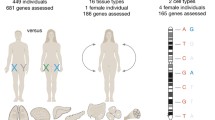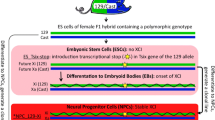Abstract
X Chromosome inactivation (XCI) silences one copy of most X-linked genes in female mammals. Notably, human and mouse differ strikingly in the number and organization of the genes that escape XCI. While on the human X Chromosome (Chr) escape genes are organized in domains, the few known genes that escape inactivation in the mouse appear to be isolated. Here we characterize the gene Cxorf26 and adjacent noncoding transcripts that map to XqD. We assess allelic expression in a nonrandomly X-inactivated cell line and directly demonstrate that 2610029G23Rik (Cxorf26) and its head-to-head neighbor (5530601H04Rik) escape X inactivation, creating a small escape domain. Both genes are robustly expressed from the inactive X Chr at approximately 50 and 30% of the expression levels of the active X, respectively. Additionally, consistent with XCI escape, the first exon of Cxorf26 is embedded within an unmethylated CpG island. To extend these results, we assayed ncRNAs adjacent to three other escape genes, Eif2s3x, Kdm5c, and Ddx3x. By allelic expression, three ncRNAs (D330035k16Rik, D930009k15Rik, and Gm16481) also escape X inactivation in the mouse, consistent with previous studies that reported female-biased expression. Altogether, these results establish that mouse escapees, like their human counterparts, can be clustered. Moreover, the fact that these ncRNAs are not found on the human X raises intriguing questions about potential regulatory roles of rapidly evolving ncRNAs in controlling escape gene expression.




Similar content being viewed by others
References
Anderson C, Brown C (2005) Epigenetic predisposition to expression of TIMP1 from the human inactive X chromosome. BMC Genet 6:48
Berletch JB, Yang F, Disteche CM (2010) Escape from X inactivation in mice and humans. Genome Biol 11:213
Brockdorff N, Ashworth A, Kay GF, McCabe VM, Norris DP, Cooper PJ, Swift S, Rastan S (1992) The product of the mouse Xist gene is a 15 kb inactive X-specific transcript containing no conserved ORF and located in the nucleus. Cell 71:515–526
Brown CJ, Hendrich BD, Rupert JL, Lafreniere RG, Xing Y, Lawrence J, Willard HF (1992) The human XIST gene: analysis of a 17 kb inactive X-specific RNA that contains conserved repeats and is highly localized within the nucleus. Cell 71:527–542
Carrel L, Willard H (2005) X-inactivation profile reveals extensive variability in X-linked gene expression in females. Nature 434:400–404
Carrel L, Hunt P, Willard H (1996) Tissue and lineage-specific variation in inactive X chromosome expression of the murine Smcx gene. Hum Mol Genet 5:1361–1366
Carrel L, Park C, Tyekucheva S, Dunn J, Chiaromonte F, Makova K (2006) Genomic environment predicts expression patterns on the human inactive X chromosome. PLoS Genet 2:e151
Chaumeil J, Le Baccon P, Wutz A, Heard E (2006) A novel role for Xist RNA in the formation of a repressive nuclear compartment into which genes are recruited when silenced. Genes Dev 20:2223–2237
Chow JC, Ciaudo C, Fazzari MJ, Mise N, Servant N, Glass JL, Attreed M, Avner P, Wutz A, Barillot E, Greally JM, Voinnet O, Heard E (2010) LINE-1 activity in facultative heterochromatin formation during X chromosome inactivation. Cell 141:956–969
Chureau C, Chantalat S, Romito A, Galvani A, Duret L, Avner P, Rougeulle C (2011) Ftx is a non-coding RNA which affects Xist expression and chromatin structure within the X-inactivation center region. Hum Mol Genet 20:705–718
Ciavatta D, Kalantry S, Magnuson T, Smithies O (2006) A DNA insulator prevents repression of a targeted X-linked transgene but not its random or imprinted X inactivation. Proc Natl Acad Sci USA 103:9958–9963
Clemson CM, McNeil JA, Willard HF, Lawrence JB (1996) XIST RNA paints the inactive X chromosome at interphase: evidence for a novel RNA involved in nuclear/chromosome structure. J Cell Biol 132:259–275
Cordaux R, Batzer MA (2009) The impact of retrotransposons on human genome evolution. Nat Rev Genet 10:691–703
Disteche C (1995) Escape from X inactivation in human and mouse. Trends Genet 11:17–22
Disteche C (1999) Escapees on the X chromosome. Proc Natl Acad Sci USA 96:14180–14182
Disteche C, Filippova G, Tsuchiya K (2002) Escape from X inactivation. Cytogenet Genome Res 99:36–43
Duret L, Chureau C, Samain S, Weissenbach J, Avner P (2006) The Xist RNA gene evolved in eutherians by pseudogenization of a protein-coding gene. Science 312:1653–1655
Ehrmann I, Ellis P, Mazeyrat S, Duthie S, Brockdorff N, Mattei M, Gavin M, Affara N, Brown G, Simpson E, Mitchell M, Scott D (1998) Characterization of genes encoding translation initiation factor eIF-2gamma in mouse and human: sex chromosome localization, escape from X-inactivation and evolution. Hum Mol Genet 7:1725–1737
Elisaphenko EA, Kolesnikov NN, Shevchenko AI, Rogozin IB, Nesterova TB, Brockdorff N, Zakian SM (2008) A dual origin of the Xist gene from a protein-coding gene and a set of transposable elements. PLoS One 3:e2521
Faulkner GJ, Kimura Y, Daub CO, Wani S, Plessy C, Irvine KM, Schroder K, Cloonan N, Steptoe AL, Lassmann T, Waki K, Hornig N, Arakawa T, Takahashi H, Kawai J, Forrest ARR, Suzuki H, Hayashizaki Y, Hume DA, Orlando V, Grimmond SM, Carninci P (2009) The regulated retrotransposon transcriptome of mammalian cells. Nat Genet 41:563–571
Filippova G, Cheng M, Moore J, Truong J, Hu Y, Nguyen D, Tsuchiya K, Disteche C (2005) Boundaries between chromosomal domains of X inactivation and escape bind CTCF and lack CpG methylation during early development. Dev Cell 8:31–42
Gartler SM, Riggs AD (1983) Mammalian X-chromosome inactivation. Annu Rev Genet 17:155–190
Goto Y, Kimura H (2009) Inactive X chromosome-specific histone H3 modifications and CpG hypomethylation flank a chromatin boundary between an X-inactivated and an escape gene. Nucleic Acids Res 37:7416–7428
Greenfield A, Carrel L, Pennisi D, Philippe C, Quaderi N, Siggers P, Steiner K, Tam P, Monaco A, Willard H, Koopman P (1998) The UTX gene escapes X inactivation in mice and humans. Hum Mol Genet 7:737–742
Jegalian K, Page DC (1998) A proposed path by which genes common to mammalian X and Y chromosomes evolve to become X inactivated. Nature 394:776–780
Kalitsis P, Saffery R (2009) Inherent promoter bidirectionality facilitates maintenance of sequence integrity and transcription of parasitic DNA in mammalian genomes. BMC Genomics 10:498
Koerner MV, Pauler FM, Huang R, Barlow DP (2009) The function of non-coding RNAs in genomic imprinting. Development 136:1771–1783
Lee J, Davidow LS, Warshawsky D (1999) Tsix, a gene antisense to Xist at the X-inactivation centre. Nat Genet 21:400–404
Li N, Carrel L (2008) Escape from X chromosome inactivation is an intrinsic property of the Jarid1c locus. Proc Natl Acad Sci USA 105:17055–17060
Lopes A, Burgoyne P, Ojarikre A, Bauer J, Sargent C, Amorim A, Affara N (2010) Transcriptional changes in response to X chromosome dosage in the mouse: implications for X inactivation and the molecular basis of Turner Syndrome. BMC Genomics 11:82
Lyon M (1998) X-chromosome inactivation: a repeat hypothesis. Cytogenet Cell Genet 80:133–137
Marks H, Chow J, Denissov S, Françoijs K, Brockdorff N, Heard E, Stunnenberg H (2009) High-resolution analysis of epigenetic changes associated with X inactivation. Genome Res 19:1361–1373
Mercer TR, Dinger ME, Mattick JS (2009) Long non-coding RNAs: insights into functions. Nat Rev Genet 10:155–159
Payer B, Lee J (2008) X chromosome dosage compensation: how mammals keep the balance. Annu Rev Genet 42:733–772
Penny GD, Kay GF, Sheardown SA, Rastan S, Brockdorff N (1996) Requirement for Xist in X chromosome inactivation. Nature 379:131–137
Polak P, Domany E (2006) Alu elements contain many binding sites for transcription factors and may play a role in regulation of developmental processes. BMC Genomics 7:133
Reinius B, Shi C, Hengshuo L, Sandhu K, Radomska K, Rosen G, Lu L, Kullander K, Williams R, Jazin E (2010) Female-biased expression of long non-coding RNAs in domains that escape X-inactivation in mouse. BMC Genomics 11:614
Sheardown S, Norris D, Fisher A, Brockdorff N (1996) The mouse Smcx gene exhibits developmental and tissue specific variation in degree of escape from X inactivation. Hum Mol Genet 5:1355–1360
Speek M (2001) Antisense promoter of human L1 retrotransposon drives transcription of adjacent cellular genes. Mol Cell Biol 21:1973–1985
Talebizadeh Z, Simon S, Butler M (2006) X chromosome gene expression in human tissues: male and female comparisons. Genomics 88:675–681
Trinklein N, Aldred S, Hartman S, Schroeder D, Otillar R, Myers R (2004) An abundance of bidirectional promoters in the human genome. Genome Res 14:62–66
Tsuchiya K, Greally J, Yi Y, Noel K, Truong J, Disteche C (2004) Comparative sequence and X-inactivation analyses of a domain of escape in human xp11.2 and the conserved segment in mouse. Genome Res 14:1275–1284
Wang Z, Willard H, Mukherjee S, Furey T (2006) Evidence of influence of genomic DNA sequence on human X chromosome inactivation. PLoS Comput Biol 2:e113
Waters PD, Dobigny G, Waddell PJ, Robinson TJ (2007) Evolutionary history of LINE-1 in the major clades of placental mammals. PLoS One 2:e158
Yamada Y, Watanabe H, Miura F, Soejima H, Uchiyama M, Iwasaka T, Mukai T, Sakaki Y, Ito T (2004) A comprehensive analysis of allelic methylation status of CpG islands on human chromosome 21q. Genome Res 14:247–266
Yang F, Babak T, Shendure J, Disteche CM (2010) Global survey of escape from X inactivation by RNA-sequencing in mouse. Genome Res 20:614–622
Yen ZC, Meyer IM, Karalic S, Brown CJ (2007) A cross-species comparison of X-chromosome inactivation in Eutheria. Genomics 90:453–463
Acknowledgments
We thank Isabel Castro for kindly providing the female mouse RNAs. IPATIMUP is an Associate Laboratory of the Portuguese Ministry of Science, Technology and Higher Education and is partially supported by FCT, the Portuguese Foundation for Science and Technology. AML is the recipient of a postdoctoral fellowship from FCT (FRH/BPD/26702/2006). LC acknowledges support from the NIH (HD056452).
Author information
Authors and Affiliations
Corresponding authors
Electronic supplementary material
Below is the link to the electronic supplementary material.
Rights and permissions
About this article
Cite this article
Lopes, A.M., Arnold-Croop, S.E., Amorim, A. et al. Clustered transcripts that escape X inactivation at mouse XqD. Mamm Genome 22, 572–582 (2011). https://doi.org/10.1007/s00335-011-9350-6
Received:
Accepted:
Published:
Issue Date:
DOI: https://doi.org/10.1007/s00335-011-9350-6




